THE TRAMWAYS OF PERU (original) (raw)
The Tramways of LIMA, PERU
BYAllen Morrison
This website has three parts. Go to Part 1: 1864-1904Part 3: 1928-1965Part 4: 1997-
Part 2: 1905-1927
The construction of electric tram lines to Chorrillos and Callao [see Part 1] sparked interest in electric transport throughout the city. The Ferro-Carril Urbano prepared to electrify its horsecar system but was upstaged by a new group, Compañía de Automóviles de Lima, which purchased six battery-powered buses from J. G. Brill in August 1904. The self-propelled vehicles, which may have been the first of their kind in the world, were placed in service between Plaza de Armas and the Exposición in 1905 [see map]. But their motors were weak, the batteries burned out, and after two months Lima's rubber-tired trams were rebuilt to run on gasoline.
Ferro-Carril Urbano acquired permission to electrify its lines in April 1905 and in July ordered 40 4-wheel electric trams from John Stephenson Co. in New York. The photograph below, taken before attachment of the trolley pole and truck, shows a vehicle from a second batch of 20 identical cars purchased in 1906 [Brill's Magazine, Philadelphia, 2/1907, p. 26]:
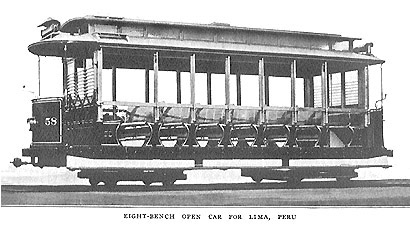
Ferro-Carril Urbano de Lima inaugurated its electric tramway system on Friday night 1 June 1906. The postcard below shows the FCUL executives and their staff [postcard, col. AM]:
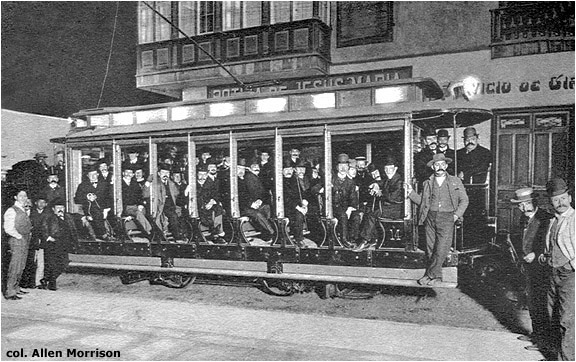
The first line ran from Calle Malambito, near Plaza 2 de Mayo, east on Calles Moquegua and Puno to Plaza Cocharcas (at today's Av. Huanuco), returning west on Cuzco and Emancipación [see map]. The "Malambito-Cocharcas" route would become the city's trolleybus line in 1928. "Calle Mariquitas" noted below is Calle Moquegua today [col. AM]:
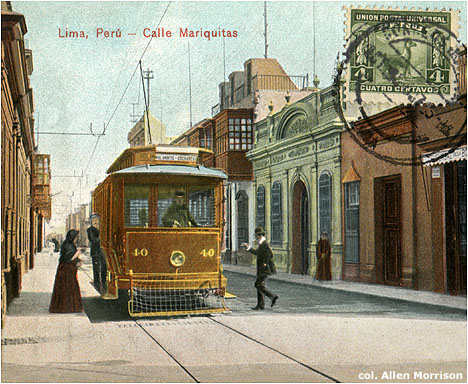
Five more electric routes opened later that year. The last one, inaugurated on 31 December 1906, crossed the river into Rimac [see map]. The tram on this postcard waits in front of the terminal of the Tranvía Eléctrico de Lima y Chorrillos, which was shown and discussed in Part 1. The letters "TORIA" on the sign extreme left mark La Victoria station of the Lima Railways steam line [col. AM]:
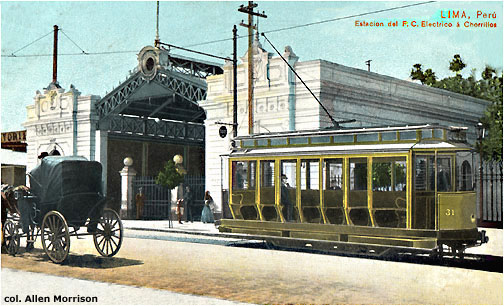
Meanwhile, a new organization, Compañía Nacional de Tranvía Eléctrico, received permission to build a second electric tramway from Lima to Chorrillos. CNTE purchased the horsecar line that ran alongside Lima Railways and built a depot and power plant at Limatambo, which it equipped with German turbines and boilers. It ordered an 8-wheel electric tram from St. Louis Car Co. in 1905, seven more similar vehicles in 1906.
Both Lima Railways and Tranvía Eléctrico de Lima y Chorrillos, which had been running trolleys to Chorrillos since 1904, were unhappy with this development and the latter tried to sabotage the CNTE project. But CNTE persisted and opened its 13 km electric line, from the Cathedral in downtown Lima to Calle Castilla in Chorrillos, on 1 October 1907 [see map]. The following March it extended the tramway through a 208 m tunnel to La Herradura beach. Its trams collected current with Siemens pantographs, rather than American-style trolley poles [Prisma, Lima, 3/1908, p. 11]:
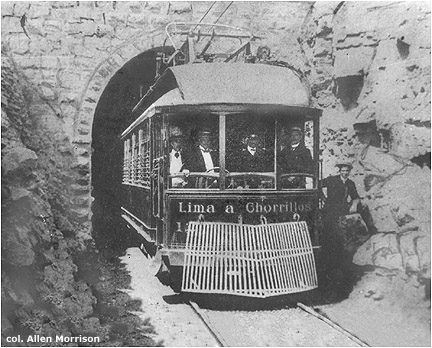
The rare photograph below shows a St. Louis tram at a station on the beach. The picture was taken after its pantograph had been replaced with trolley poles. Note the distinctive, curved Siemens-style hangers for the overhead wire [col. AM]:
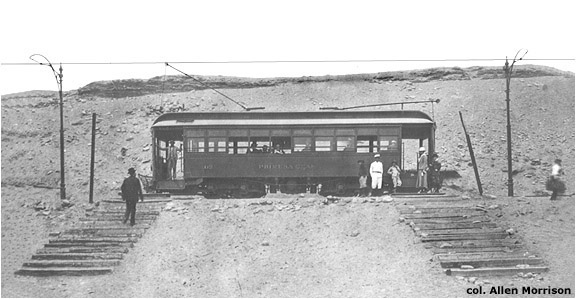
La Herradura's tennis court had a good view of the tram line. The car seems to be a Stephenson model from 1904. Judging from the rails in the foreground, the tramway's descent to sea level followed a sinuous route [col. AM]:
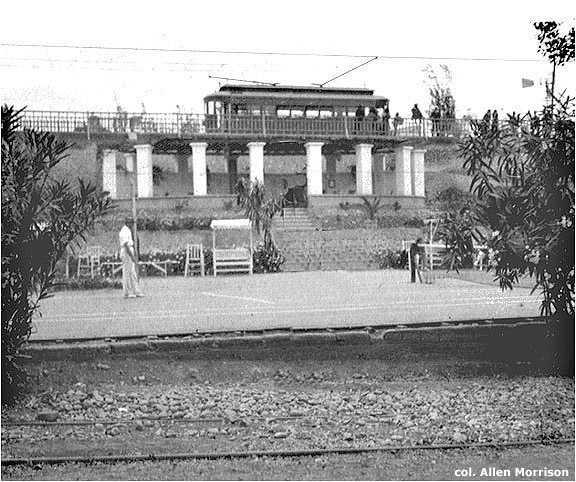
CNTE ordered six more trams from Waggonfabrik Falkenried in Hamburg, Germany - which were built but apparently never sent to Peru. Despite its fine equipment and popular line to the shore, CNTE could not compete with TELC and filed for bankruptcy in June 1908, eight months after it began. The photograph below of car 5 was taken at the Falkenried factory. As on the St. Louis car above, the inscription on the front says "Lima a Chorrillos" [Siemens Museum, Munich]:
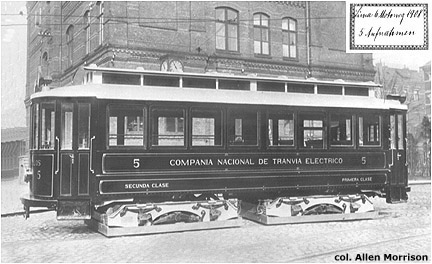
The city's next electrification took place in 1909. In November 1906 Lima Railways, which had been operating steam trains to Callao and Chorrillos for 50 years, acquired the Magdalena steam railway and hired Empresa Eléctrica de Santa Rosa to build an electric tram line in its place [see map]. Alberto Regal [see BIBLIOGRAPHY] states that construction was completed in April 1909, but the panoramic photograph below is labeled "Inauguration of the Electric Railway from Lima to Magdalena del Mar / First Car / January 1909" [col. AM]:
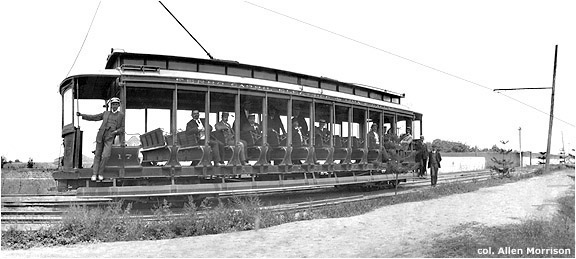
The tramway path above is Av. Brasil today. The lettering along the roof line of open car 17, built by Brill in 1904, says "Ferro Carril Eléctrico de Lima y Callao". The latter company apparently sold it to Lima Railways. The poorly framed panoramic view below shows the same car, probably on the same day. Location is thought to be LR's Lechugal de San Jacinto station on Calle Quilca [see map]. Identity of the locomotive is unknown [col. AM]:
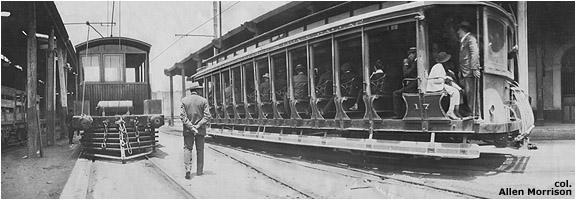
Lima's four electric tramway operators - FC Urbano, the companies that ran interurban lines to Chorrillos and Callao, and Lima Railways which ran the line to Magdalena - all purchased power from Empresas Eléctricas de Santa Rosa, which also lit the lights of the city. The electricity company and the railways formed a consortium in 1906, Empresas Eléctricas Asociadas, to share resources, equipment and expenses. The merger was not made official until 1909 and formally recognized by the Peruvian government until 1910. British capital was involved and EEA was also known as Lima Light, Power & Tramways Co. The initials "LLPTC" appeared on the cars and the company passes [col. AM]:
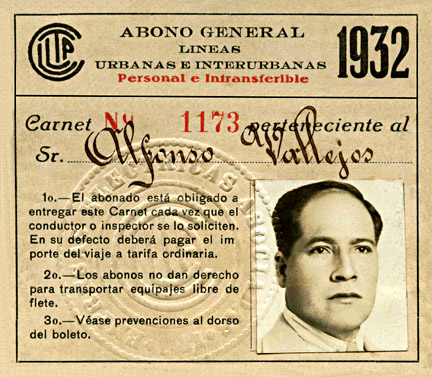
but the Spanish name was shown on the tickets [col. AM]:

One of the provisions of the merger was that the Lima Railways steam lines no longer carry passengers to Chorrillos and Callao, that they not compete with the electric tram lines. LR agreed to carry only freight - but electrified its system in 1913 and created the third electric railway between Lima and Chorrillos!
Now that the Chorrillos tram line was part of the EEA system, its cars ran straight through the former TELC station at "Exposición" [see map]. The photo below shows one of the St. Louis cars originally owned by the CNTE and seen in the 5th photo above. (The TELC station can also be seen in the 4th photo above and in Part 1) [col. AM]:
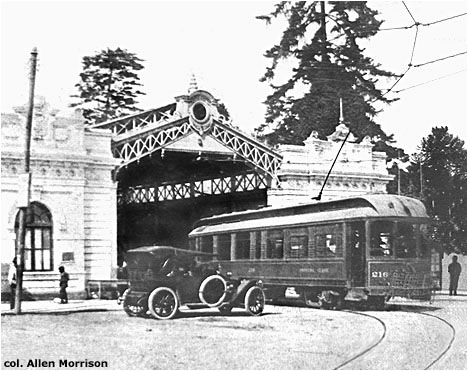
EEA enlarged its network in central Lima and numbered its routes 1 to 9. It electrified horsecar lines in Miraflores and Barranco. It took over CNTE's tracks on Avenidas Pedro Osma and Chorrillos and the extension to La Herradura, and closed its old line on Av. Escuela Militar [see map]. It reopened CNTE's abandoned factory at Limatambo, rebuilt old equipment and began to construct new tramcars. By 1912 it operated 75 electric trams on the urban system and 60 on the lines to Chorrillos, Magdalena and Callao, and also owned six electric locomotives. In 1913 EEA ordered eight unusual trams from J. G. Brill, which would be its last U.S. imports for many years [col. AM]:
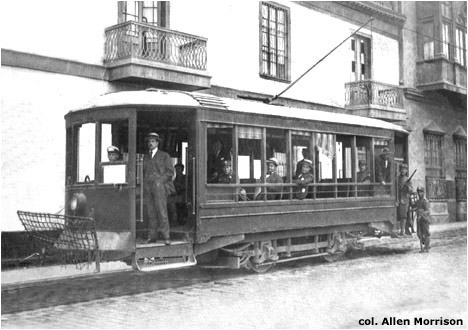
The photograph below shows 16th century Inca ruler Manco Cápac pointing toward downtown Lima. (Is he telling the motorman to return to town?) The tram, a reconstructed old model, is traveling south on Av. Manco Cápac, formerly Av. Santa Teresa. This is the La Victoria tram line, a remnant of the ill-fated CNTE route to Chorrillos [see text above and map]. Note the curved, German-style wire hanger on the left [col. AM]:
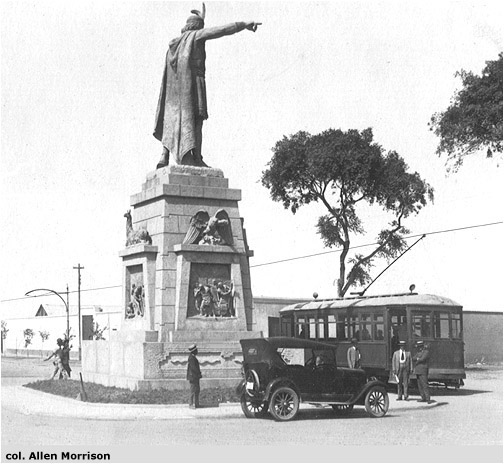
The 4 August 1917 edition of the New York publication Electric Railway Journal [see BIBLIOGRAPHY] describes the rolling stock that EEA has built in Peru. An example is this large sprinkler car for use on its suburban lines [_Electric Railway Journal_]:
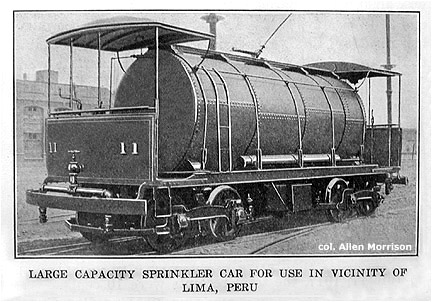
A dramatic event took place in 1921. Largely through the initiative of Italian engineer Juan Carosio, who had installed the electric tramway in Asunción, Paraguay, in 1913, EEA/LLPTC was acquired by the Latina Lux empire in Italy and began to buy electric trams from Società Ernesto Breda in Milan. At least 66 single-truck cars (similar to those that Carosio had purchased for Asunción) and 36 large 8-wheel models with arched windows arrived in Lima in the next four years. Here is the 4-wheel model designed for city service. The round emblem above the number displays the initials "LLPTC" [col. AM]:
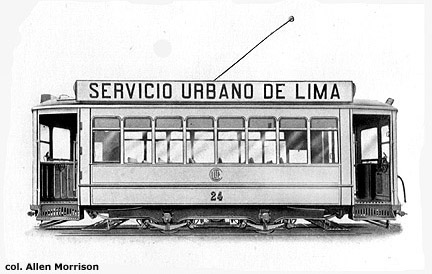
And here is the 8-wheeler built for the suburban lines. The double-truck model came in both motor and trailer versions [col. AM]:
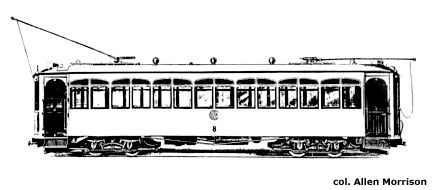
The fleet numbers that EEA assigned to its trams seem to have little relation to the numbers painted in Milan. The postcard view below, from the 1920s, shows two of the Italian city cars, still new, on routes 1 and 4 [see map]. The mules in the foreground seem unimpressed [col. AM]:
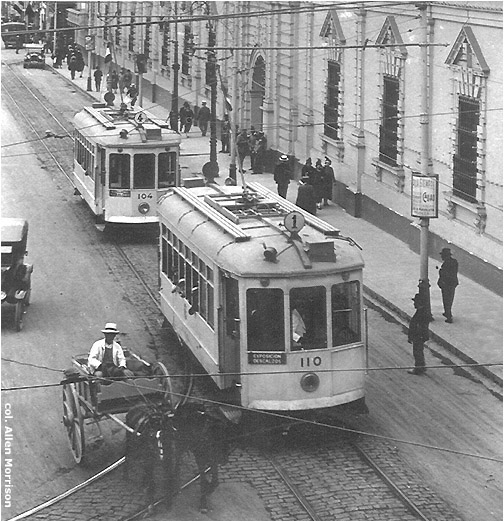
Here is a mean-looking bunch, defying a NO SMOKING sign ("Es Prohibido Fumar"), on Breda suburban car 259. The identity of the passengers and the date of the photograph are unknown [col. AM]:
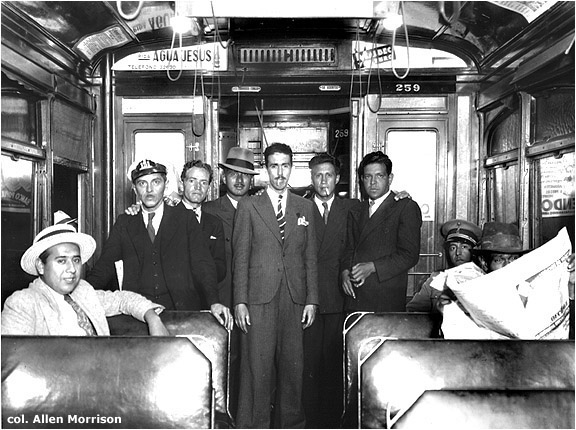
There were even more dramatic developments in 1928 and 1929: EEA closed most of its tram lines in central Lima, started running trolleybuses which it converted to trams, and returned to buying equipment from the United States.
See Part 3.
The author is grateful to Lima resident Elio Galessio for information about his city and the railways and tramways that ran there. He is also indebted to Harold E. Cox of Wilkes-Barre for information about tram car orders.
BIBLIOGRAPHY (in order of publication)
Empresas Eléctricas Asociadas. Plano General de los Ferrocarriles Eléctricos de Lima, Callao y Chorrillos. Lima, n.d. [1906]. Map at scale 1:50,000 shows all tram lines in the area, including (despite title) steam and animal-powered.
Emilio Guarini. El Porvenir de la Industria Eléctrica en el Perú. Lima, 1907. "Los automóviles eléctricos ó acumuladores de Lima", pp. 414-420, details the operation of Lima's battery-powered buses. "Visita a la central del tranvía eléctrico nacional", pp. 737-739, describes the Limatambo shops, its machinery and the vehicles of the CNTE.
Camilo Vallejos Z. Plano Topográfico de Lima, Callao y sus Alrededores. Lima, 1907. Map at scale 1:80,000 shows "ferrocarriles a vapor y eléctricos".
"The Electric Tramway System of Lima, Peru" in Street Railway Journal (New York), 4/5/1907, pp. 792-795. History and description of the electric lines and the formation of Empresas Eléctricas Asociadas. Eight photographs, a map and a diagram of the track layout in the carbarn.
"Tranvía Eléctrico Nacional" in El Comercio (Lima), 1/10/1907. Newspaper article about the dispute between the CNTE and the TELC.
Perú. Dirección de Obras Públicas y Vías de Comunicación. Memoria, 1907. Lima, 1907. "Ferrocarriles Urbanos" on pp. XLVII-LI, presents detailed itineraries of the nine urban lines.
"Electric Omnibuses" in The Electrician (London), 28/2/1908, p. 767. Description of problems with the battery buses.
Prisma (Lima), 3/1908. Several photographs of the La Herradura beach tramway, including the tunnel view reproduced on this webpage, p. 11.
Federico Costa y Laurent. Reseña Histórica de los Ferrocarriles del Perú. Lima, 1908. Excellent articles on the two Chorrillos electric lines, pp. 127-131. Photos and fare charts on unnumbered pages.
Marie Robinson Wright. The Old and the New Peru. Philadelphia, 1908. A large photograph on p. 184 shows a battery-powered bus in operation.
Ricardo Tizón i Bueno. Plano de Lima, 1908. Lima, n.d. [1908]. Superb map at scale 1:10,000 shows tram lines in central area, identified by letter. Only map found that shows and identifies the new CNTE electric line [see Part 2].
"Semi-Convertible Cars for the Capital of Peru" in Brill's Magazine (Philadelphia), 4/1909, pp. 80-85. Description of the trams and routes of the early electric lines. Nice photographs of La Legua tram depot and the Santa Rosa power plant (inside and out).
"Lima, Peru" in Brill Magazine (Philadelphia), 10/1911, pp. 274-280. Feature article on the tramway installation. Eight photographs.
"Lima Tramways Company" in Brill Magazine (Philadelphia)m 10/1913, pp. 305-307. Illustrated article about new cars for the suburban lines.
"The Lima Light, Power and Tramways Company" in Recueil Financier, 1913 (Bruxelles/Brussel), p. 882. Finances and brief description (in French) of the system.
Reginald Lloyd. Impresiones de las Repúblicas Sud-Americanas del Oeste en el Siglo XX. London, 1915. A chapter on the "Empresas Eléctricas Asociadas (Lima Light, Power and Tramways Co.)" on pp. 206-209 provided extremely detailed data about the finances and operation of the company. Good description of the rolling stock and lines.
South American Year Book, 1915. London, 1915. Interesting description and historical notes on the railways and tramways in the LIma area, pp. 694-697.
"Lima, Peru, Has Enterprising Electric Railway System" in Electric Railway Journal (New York), 4/8/1917, pp. 180-181, describes the sprinkler car and a meat car that EEA built in its shops.
U.S. Bureau of Foreign & Domestic Commerce. Special Agents Series no. 154 (1917). Washington, 1917. A chapter on "Traction" in Lima, pp. 34-35, says that "The rolling stock and all the material used, except five old and practically disused cars, came from the United States." Where did those five trams come from? Could the Falkenried cars mentioned above have gone to Peru?
U.S. Bureau of Foreign & Domestic Commerce. Special Agents Series no. 175 (1919). Washington, 1919. "Lima Light, Power & Tramways Co.", pp. 138-139, describes the installation, rolling stock and finances.
"Fast Schedule Line in Peru" in Electric Traction (Chicago), 4/1920, pp. 257-258. Illustrated article about the high speeds attained on the suburban tram lines.
Concejo Provincial. Plano Oficial de la Ciudad de Lima en 1921. Lima, 1921. Street map of the central area shows track detail of the tram routes.
W. E. Dunn. Peru: A Commercial and Industrial Handbook. Washington, 1925. A description of Lima power plants and tramway lines, pp. 332-334, provides interesting data.
Santiago Antúnez de Mayolo. La Génesis de los Servicios Eléctricos de Lima. Lima, 1929. Excellent survey of the development of electricity and electric transport. Four photographs.
Lascano & López. Plano de Lima, Callao y Balnearios. From its Guía Lascano. Lima, n.d. [about 1929]. Large map of entire city shows tramway and railway lines in detail.
Juan Bromley & José Barbagelata. Evolución Urbana de la Ciudad de Lima. Lima, 1945. Brief description of tramway development, pp. 96-97. History ends in 1921.
Alberto Regal. Historia de los Ferrocarriles de Lima. Lima, 1965. A monumental work. History and description of all the railways and tramways in the Lima area, including the Callao local lines (chapter V); Lima local lines (IX); Lima-Chorrillos lines (X); Lima-Callao line (XI); Lima-Magdalena lines (VIII). Numerous photographs and excellent maps.
Municipalidad de Lima Metropolitana. Planos de Lima, 1613-1983. Lima, 1983. Folio of 30 maps, many showing tram routes.
Juan Carlos Arroyo Ferreyros. "El Tranvía" in Concertando (Lima), 9-10/1994, pp. 7-10. Good historical survey. Data mostly from Regal, above. Four photos, seven charts.
Trevor H. Stephenson. Peruvian Trams and Railways: An Illustrated History. London, 1995. Lima railways and tramways, pp. 23-57. Brief text, unidentified illustrations, maps copied (without credit) from the Regal work noted above.
"Personajes de Alto Voltaje: Juan Carosio" in El Tranviario, monthly bulletin of the Museo de la Electricidad (Lima), 10/2001, pp. 3-4. Brief biography of the Italian engineer who developed electric power and tramways in Argentina, Uruguay, Paraguay and Peru.
César Jiménez.Historias de los tranvías en Lima. [1998] Nice historical survey of tramway development. Text, 12 photographs, diagrams of the urban lines, enlargeable map of the suburban network.
Go to Part 1: 1864-1904Part 3: 1928-1965Part 4: 1997-
The first pages of this website were uploaded on 30 December 2003
Please send comments, corrections & suggestions to Allen Morrison
Visit my homepage aboutElectric Transport in Latin America
Copyright © 2004-2104 Allen Morrison - ALL RIGHTS RESERVED